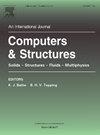A new three-dimensional model of train-track-bridge coupled system based on meshless method and its graph neural network-based surrogate model
IF 4.8
2区 工程技术
Q1 COMPUTER SCIENCE, INTERDISCIPLINARY APPLICATIONS
引用次数: 0
Abstract
A model of train–track–bridge coupled system is proposed to study the interactions between structures in greater detail. The new model employs a meshless method to numerically simulate the box girder bridge and track slab. In the dynamic analysis, the system at each time step is abstracted into a graph structure and trained using a graph neural network to develop a surrogate prediction model. The graph neural network node connections in the bridge top plate are determined by the meshless method. Multiple numerical examples demonstrate the differences in structural response between the proposed model and the conventional model and evaluate the performance and self-evolutionary capabilities of the surrogate model. The results indicate that, compared to the proposed model, the conventional model underestimates vertical responses by approximately 17 %–69 % and lateral responses by one to two orders of magnitude. The surrogate model demonstrates good displacement prediction capabilities for the bridge on the training dataset, achieving an value as high as 0.99. Furthermore, it exhibits robust prediction and self-evolutionary capabilities on the test dataset under topological changes, with prediction accuracy decreasing by only about 2 %. However, the prediction performance for rail responses is relatively poor, with an value as low as 0.29.
基于无网格法的列车-轨道-桥梁耦合系统三维模型及其基于图神经网络的代理模型
为更详细地研究结构间的相互作用,提出了火车-轨道-桥梁耦合系统模型。新模型采用无网格法对箱梁桥和轨道板进行数值模拟。在动态分析中,将每个时间步的系统抽象为图结构,并使用图神经网络进行训练,以建立代用预测模型。桥梁顶板的图神经网络节点连接由无网格法确定。多个数值实例证明了所提出的模型与传统模型在结构响应方面的差异,并评估了代用模型的性能和自我进化能力。结果表明,与提出的模型相比,传统模型低估了约 17%-69% 的垂直响应和一到两个数量级的横向响应。代用模型在训练数据集上表现出良好的桥梁位移预测能力,R2 值高达 0.99。此外,在拓扑变化条件下,代用模型在测试数据集上表现出稳健的预测和自我进化能力,预测精度仅下降约 2%。然而,铁路响应的预测性能相对较差,R2 值低至 0.29。
本文章由计算机程序翻译,如有差异,请以英文原文为准。
求助全文
约1分钟内获得全文
求助全文
来源期刊

Computers & Structures
工程技术-工程:土木
CiteScore
8.80
自引率
6.40%
发文量
122
审稿时长
33 days
期刊介绍:
Computers & Structures publishes advances in the development and use of computational methods for the solution of problems in engineering and the sciences. The range of appropriate contributions is wide, and includes papers on establishing appropriate mathematical models and their numerical solution in all areas of mechanics. The journal also includes articles that present a substantial review of a field in the topics of the journal.
 求助内容:
求助内容: 应助结果提醒方式:
应助结果提醒方式:


